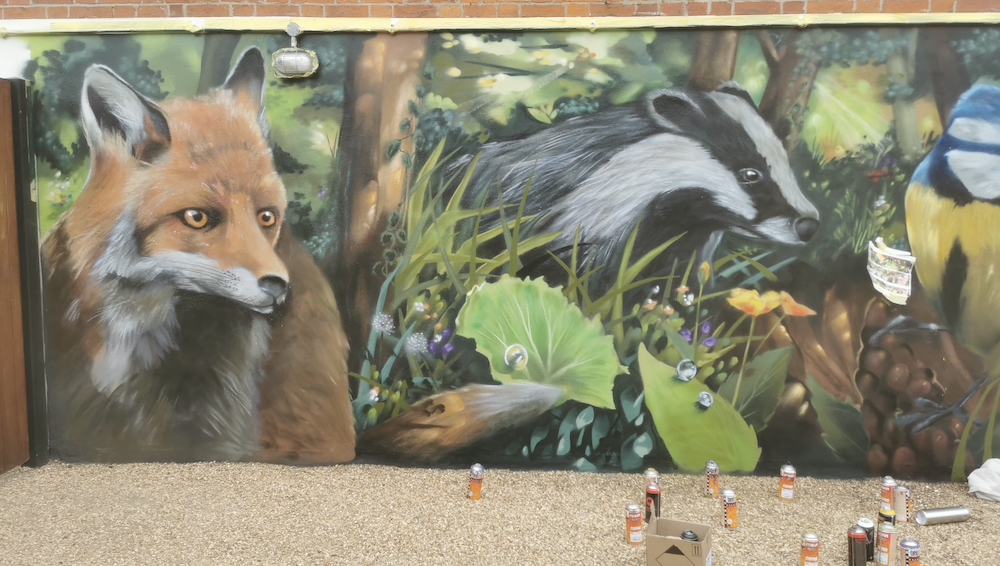
Artist Tips: How To Amplify Yourself On Social Media
Social media can be a fickle beast. The big man Zuckerberg has a unique way of keeping small businesses on their toes. Many myths and legends are surrounding what can and can’t harm your social media amplification. Book An Artist is to myth bust and tell you exactly how you can spread the word of your marvellous creation through cyberspace.
1. The tagging system…
It doesn’t matter if you’re flooding Instagram, Facebook or Twitter with your fabulous pieces the ‘@’ symbol is your new best friend. Tagging people in your posts may seem like the obvious thing to do, but sometimes it slips under the radar. Outside of notifying a client, collaborator, business or person that you’ve painted a new piece, tagging has other benefits. Not only does tagging increase the chances of being regrammed or reshared, but it also creates a “tether” between your profile and the tagged profile. This magical tether increases engagement by showing your post in the users’ tagged photos.
There is a difference between tagging a user in your photo and merely mentioning their handle in your description. Specifically, for Instagram, only mentioning their handle in your image’s description will mean your post will not end up in their tagged photos. Sometimes there is anxiety surrounding tagging people in new posts. Social media is about connecting and sharing; don’t be afraid to show people what you’ve created.

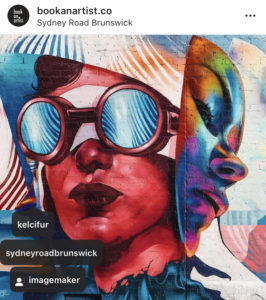
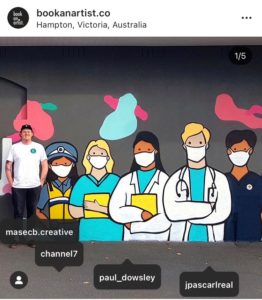
2. #hashtags…
There are many different ways to use the #hashtag feature outside of using them as a way to emote your #mondaymood. There is no shame in the hashtag game. Allocate some time out of your day and explore some unique hashtags that pertain to your area of expertise. A simple Google search will provide you with a list of popular hashtags, including #love #smile #happy. But these hashtags get bombarded with new posts every second resulting in lost work amongst a sea of selfies. Find hashtags that work for you, for example #muralartist #streetartist #localartist. These hashtags can be a little more niche, but they increase your chances of getting noticed by people interested in what you’re doing.
If you don’t like the look of dozens of hashtags dangling from your description, post your hashtags as a comment. That way, when users read your post description, they’ll be less likely to see your hashtag dump.
If you’re working on a project for a specific business or company (or would like to) check to see if they have a personalised #hashtag. For example, IMG Modelling Agency uses #WLYG (We Love Your Genes) and #TheLookout to source fresh faces to represent. Book An Artist uses #bookanartist to keep up to date with the fantastic works artists produce.
3. When to post…
Instagram no longer shows posts in chronological order, but there is still a method to the madness. The best time to post on social media according to an overwhelming flood of research is between 11am-1pm and 7pm-9pm. The consensus is that most users take a break around lunch and dinner time to scroll through their feed. Instagram, specifically, prioritizes new content, meaning the idea is to get your post out and about when people are online. This suggestion does not apply to the weekend, as most people are out and about during these times. Most people looking to hire a artist are active before and after work.
If you’re finding no change in your engagement when posting during these time frames, check your follower time zones. Instagram provides a feature for users to see the location of the majority of their followers. If you’re publishing your posts when half your followers are asleep, no one is going to see them! Switch up your tactics and manoeuvre your posting times around your base audience.
A final method to boost your post is to reply to any comments you may receive. Interactions on your post tell Instagram that it is popular, and the algorithm will sky-rocket that bad boy back to the top. Emoji’s are valid responses!
4. Why stories are important…
Don’t let a social media stories 24-hour lifecycle deter you. Stories are a great and unstructured way to share your projects and create engagement. Actively using the stories feature on Instagram and Facebook allows your audience to get to know you better. Stories are temporary posts that can act the same as published photos on your feed. You can use geolocation, hashtags and the tagging system to amplify your social media story. Sharing other artists (or businesses) work and projects via your own stories is a simple but effective networking strategy. Not only does it show you care, but it increases your chances of having your work shared. Don’t be afraid to share the love with other users! Being known as the artist who celebrates other artist’s successes is a great thing.
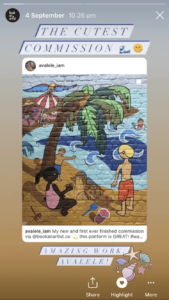
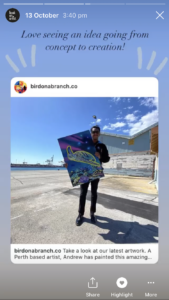
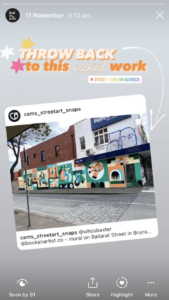
5. Share a little more about you…
Your social media accounts are yours, after all. Combining all the tips above with the added spice of your personality will ultimately result in a prize-winning social profile. Whether you’re more introverted or extraverted, curate your page to your liking and incorporate the parts of you that make your mum proud! Use your Instagram stories to discuss your latest projects or capture some behind the scenes footage. Audiences love watching an artist transform blank canvases into spectacular artworks. Engage with them by walking them through the process – tagging, hash-tagging and sharing along the way.
These small tips and tricks may seem obvious to the avid user, but it’s easy to forget why we do what we do. Small hashtags, mentions, story shares can make a world of difference to a small artist that may not post as often. Proving to Instagram and Facebook
Want more artist tips and tricks?
Tags In
Check out top-rated local artists near you!
Are you an artist ? Sign Up












